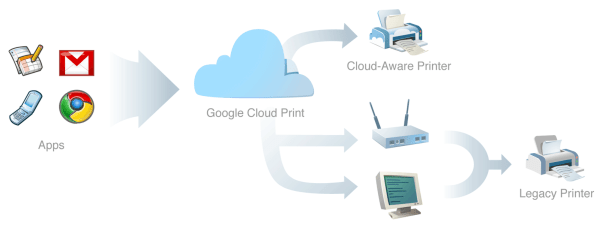
Google today answered a longstanding question today about its web-centric netbook operating system, Chrome OS: How do you print? Its solution is Google Cloud Print, a web-based method for handling print jobs in web applications, and web-enabled platforms like Chrome OS, Android, and even the iPhone.
[aditude-amp id="flyingcarpet" targeting='{"env":"staging","page_type":"article","post_id":176167,"post_type":"story","post_chan":"none","tags":null,"ai":false,"category":"none","all_categories":"business,social,","session":"A"}']Instead of using local printer drivers and software to manage print jobs, Cloud Print will enable any application that can get online to print to any printer. In effect, what Google is proposing is the next stage in printing technology.
Using its Cloud Print APIs (tools which allow developers to take advantage of the technology) developers can make their desktop, web, or mobile applications communicate with Google’s Cloud Print Service. Google also expects that others will build up their own cloud print services as well. In particular, large businesses, universities, and other organizations could find it worthwhile to build their own cloud print services for internal use, because it simplifies the process of supporting many printers across multiple platforms.
AI Weekly
The must-read newsletter for AI and Big Data industry written by Khari Johnson, Kyle Wiggers, and Seth Colaner.
Included with VentureBeat Insider and VentureBeat VIP memberships.
Users can associate their printers with Google’s print service using their Google accounts. The printers are handled similarly to documents in Google Docs, which means that they will be incredibly easy to share with others. This is yet another major benefit over current printer technology, which is far more difficult than it should be to share.
Cloud Print will support all printers currently in use today (Google calls them “legacy printers”), and “cloud-aware” printers, which don’t exist yet. A cloud-aware printer will have native support for cloud services, and doesn’t need to be connected to a computer to function. Google hopes that its Cloud Print technology will spur current printer manufacturers like HP, Canon, and Lexmark, into adopting open standards and building cloud-aware printers that will be compatible with its service, and other cloud printing services down the line. In this way, Cloud Print is very similar to Google’s other recent products which aim to direct the course of technological innovation — like Google Public DNS, and even Chrome OS itself.
As for legacy printers — which currently includes everything from old inkjet printers, to more modern ones that are networked and feature web access — Google is developing a method which will allow them to communicate with Cloud Print using a proxy. The printers will still need to be connected to computers to work, but the proxy software will allow you to share it with others, and will let you easily print from your mobile devices. Google is currently working on integrating the proxy software into Chrome on Windows, and will work on Mac and Linux versions eventually.
More modern printers could be updated eventually to become cloud-aware, and Google is hoping that printer manufacturers will be motivated to update their hardware. Some manufacturers have implemented their own cloud printing solutions, like HP’s CloudPrint, but they usually involve some interaction with a desktop to function.
There will probably be some push-back from printing companies, who have never really worked together in the past to move the printing industry forward, and are probably hesitant about jumping into bed with Google. But given the rise of smartphones, as well as the general headache that surrounds computer printing these days, it doesn’t seem like they have much of a choice.
VentureBeat's mission is to be a digital town square for technical decision-makers to gain knowledge about transformative enterprise technology and transact. Learn More
